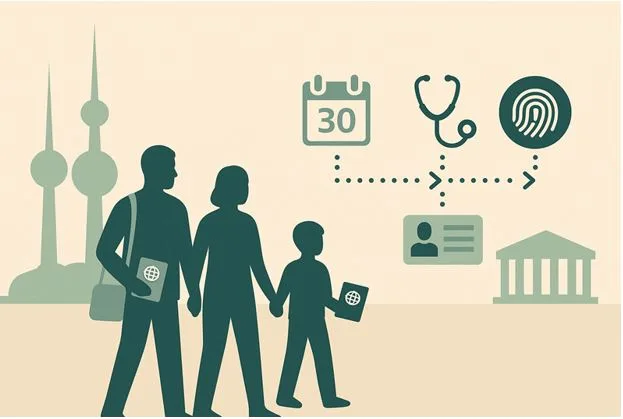Family joining in Kuwait: step-by-step from visa approval to Civil ID in hand
Bringing your spouse, children, or parents to Kuwait is straightforward if you follow the right order. This guide walks you through the process from entry visa approval to Civil ID collection, providing clear tasks, timing tips, and suggestions on how to save time and avoid repeat visits.
Before you start: requirements snapshot
Confirm eligibility and documents with your sponsor or PRO before booking anything. You’ll usually need proof of residence and income, relationship documents, passport copies, and recent photos that meet local specs.
Rules and windows change. For a quick status check on policy shifts and processing windows, see the Kuwait family visa News. For the healthcare step later, families often want to verify results online; the walkthrough here helps: Medical Report Check Online in Kuwait.
Keep a clean digital folder on your phone with PDFs and JPEGs named clearly. It speeds up counters and online forms.
Step 1: Entry visa issuance and document prep
After approval, check the visa validity to plan flights and first-week appointments. Some dependents may need attestations for marriage or birth certificates; ensure stamps and translations are in order before travel.
Book travel with enough buffer for medicals, biometrics, and PACI tasks. Aim for weekday arrivals so the first working day isn’t lost. Pack several printed photos and spare copies of passports—small prep prevents repeat trips.
Step 2: Arrival in Kuwait and first-week setup
On arrival, keep passports and visa documents together until you finish residency steps. Get a local prepaid SIM for OTPs; many portals require a Kuwaiti number for verification.
If your tenancy is not yet final, confirm a reliable mailing and collection method with your sponsor. For school-age children, begin gathering vaccination records and transcripts for later enrollments; schools often ask for Civil ID after issuance, but pre-checks save time.
Step 3: Medical fitness exam (timing and results)
Medical fitness is mandatory for most adult dependents and some older teens. Book early morning slots to reduce queues and leave time for retakes if something is missing.
Carry passports, photos, and any referral or appointment proof. Follow the center’s guidance for fasting or attire if specified. When results are released, you can often review status online rather than returning to the counter; the result-lookup steps are outlined here: Medical report check online Kuwait.
Keep the receipt and any reference numbers; you may need them for downstream steps or if a system check stalls.
Step 4: Residency stamping and biometrics
Once the medical clears, proceed to residency stamping and biometrics. Sequences vary slightly by governorate, but the common pattern is: submit residency paperwork via sponsor, then complete fingerprints and face capture at designated centers.
Book the earliest available slot. Bring originals and copies of passports, relationship documents, and the medical result reference. Dress with sleeves and avoid temporary hand decorations that could interfere with fingerprints. If a record fails to capture, ask for a same-day recapture window.
Step 5: Civil ID (PACI) application and collection
With residency granted and biometrics done, apply for the Civil ID. Many steps are online, but photos, corrections, or collection can still require a visit.
Prepare a compliant photo: neutral background, correct size, and no heavy retouching. Confirm name order and spellings in both Latin and Arabic before submission—fixing mismatches after printing takes longer. If you need current branch windows or quieter times, check an updated schedule reference, such as Kuwait family visa News from Kuwaitexpat.com for policy-driven timing notes alongside official announcements.
When the card is ready, you’ll typically receive an SMS or see the status change online. Collect promptly; many sign-ups for schools, banking, and insurance require the Civil ID number.
Step 6: What to do next (schools, banking, and utilities)
Schools usually accept pre-enrollment with passports and prior transcripts, then request Civil ID copies when issued. Start the conversation early so your child’s place is secure.
For banking, most institutions require Civil IDs for dependents who will hold accounts. If you only need supplementary cards or allowances, check your bank’s family offerings—some are faster to issue once IDs are active.
If moving into a new apartment, ask the landlord which documents they require for access cards and parking. Keep tenancy contracts, ID copies, and a phone bill or proof of address handy; you’ll reuse them often in the first months.
Compact process table (timeline and cost touchpoints)
| Phase | Typical window | Main tasks | Cost buckets (no prices) | Time-saver tip |
| Entry visa issued | Before travel | Validate documents; plan weekday arrival | Document attestations, translations | Pack extra photos and copies |
| Week 1 | Arrival | Kuwait SIM for OTPs; file setup | SIM activation, photocopies | Name files clearly for counters |
| Week 1–2 | Medical fitness | Exam, labs, result verification | Exam fee, retests if any | Book early; verify results online |
| Week 2–3 | Residency & biometrics | Paperwork, fingerprints/face | Admin fees, photos | First-slot bookings reduce queues |
| Week 3–4 | Civil ID (PACI) | Photo, application, collection | ID issuance, courier if used | Check status; collect promptly |
| Post-ID | After issuance | Schools, banking, utilities | School fees, bank services | Carry a small “docs pack” at all times |
Time-savers and common pitfalls
Use the right order. Medical → residency → biometrics → PACI keeps you from looping back and forth across counters.
Arrive early with spares. Two compliant photos and photocopies of passports often save a day.
Watch name consistency. Make sure names match across passport, residency, and Civil ID. Correct before printing the card.
Stay updated on rule changes. Processing windows and eligibility for certain relatives can shift. For concise updates.
FAQ
How long does the whole process take for a typical family?
Four to six weeks is common, but it depends on document readiness, appointment availability, and peak seasons. Starting medicals and bookings early keeps things moving.
Can I check medical results without revisiting the clinic?
In many cases you can review the status online using your reference; see the simple steps.
Do children need biometrics?
Requirements vary by age and policy updates. Confirm at the time of appointment booking; if not required, you’ll skip that visit.






